It’s that time of year again – backpacks are being dusted off, school supplies are being gathered, and there’s that familiar back-to-school buzz in the air. But this year, there’s an added layer of concern for many health professionals, particularly regarding vaccination rates among our youngest students.
Reports from states like Missouri highlight a worrying trend: kindergarten vaccination rates are dipping below the threshold needed for community immunity. This isn’t just a statistic; it’s a signal that our collective protection against preventable diseases is weakening.
Did you know that herd immunity, or community immunity, is crucial for protecting everyone, especially those who can’t be vaccinated due to age or medical conditions? When enough people in a community are vaccinated, it becomes much harder for diseases to spread. Think of it like a firewall for public health.
Public health officials are sounding the alarm, with some Ohio doctors expressing concern over similar declines in their state. The emphasis is clear: ensuring children are up-to-date on their vaccinations is a critical step in preparing for a safe school year. It’s not just about individual protection; it’s about safeguarding the entire school community.
Why might this be happening? The landscape of public health has certainly seen shifts, with increased vaccine skepticism playing a role. This trend, often fueled by misinformation, can unfortunately spill over into real-world consequences for public health.
As a scientist, I understand the importance of data and evidence. The scientific consensus on the safety and efficacy of vaccines is robust. They are one of the most effective tools we have to prevent serious illness, hospitalizations, and deaths from diseases like measles, polio, and whooping cough.
When vaccination rates drop, we risk bringing back diseases that we thought were under control. This can strain our healthcare systems and, more importantly, put vulnerable children at risk. It’s a situation where we’re all connected, and the health of one impacts the health of many.
So, what can we do? It starts with staying informed from reliable sources – your pediatrician, your local health department, and reputable scientific organizations. Open conversations with healthcare providers can help address concerns and clarify any misinformation. Ensuring our children are vaccinated is a vital part of ensuring they can learn and thrive in a safe environment.
This isn’t about blame; it’s about collective responsibility and understanding the science that protects us all. Let’s work together to ensure our schools remain safe havens for learning and growth.

